This Sunday’s Allsvenskan games were full of goals, including a seven-goal thriller between IK Sirius and Malmo FF at the Studenternas IP. Despite leading the game at the break, the home team did not make the efforts counted as the Himmelsblått had a strong second half.
In this tactical analysis, we are analyzing the intriguing tactics of Henrik Rydström and Jon Dahl Tomasson.
Lineups
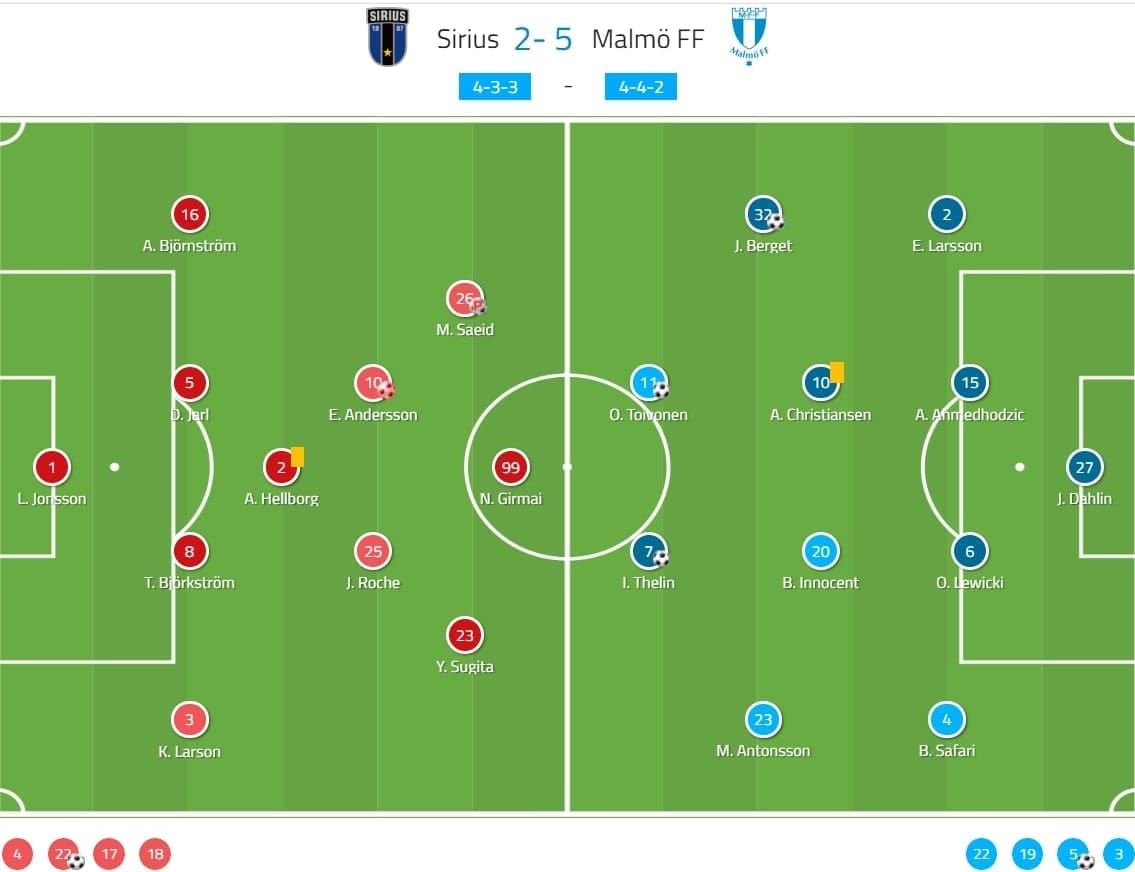
Because of the extremely tight schedule, Rydström had to rotate the squad a bit and the formation was switched to a 4-3-3. Stefano Holmquist Vecchia was replaced by Jamie Roche, who played as the advanced midfielder. Nahom Girmai Netabay was the false-9, and Mohammed Saeid moved to the left-winger position.
Malmö were playing in a 4-4-2, starting the strongest available squad. Behrang Safari started another game ahead of Jonas Knudsen. Marcus Antonsson was the left-winger as Søren Rieks stayed on the bench.
Malmö flexibility in the press
Malmö were pressing quite high in this game, perhaps the setup was a bit greedy. The press was mostly involving five players as Bonke Innocent tended to stay deeper. They were not adopting any man-marking approach, just trying to trap the ball at one flank by the shadowing works.
The presses were mostly led by Isaac Kiese Thelin, who tried to nullify the 2 v 3 underload in the first line by applying pressure. Ola Toivonen or Anders Christiansen would support the striker and provide the defensive cover. In this example, Kiese Thelin’s position was accessible to three targets, plus, the body orientation was luring the ball to the Malmö right flank.
In the wide areas, Malmö were quick to compress spaces and man-mark players nearby the ball. This often speeded up the plays, which limited the quality of the out-balls.
The wingers were positioning themselves narrowly to mark multiple targets, this ensured the flexibility in the press as Christiansen might support the striker. Taking Jo Inge Berget below as an example, who stayed between the midfield and the left-back, so jumping to either target as possible.
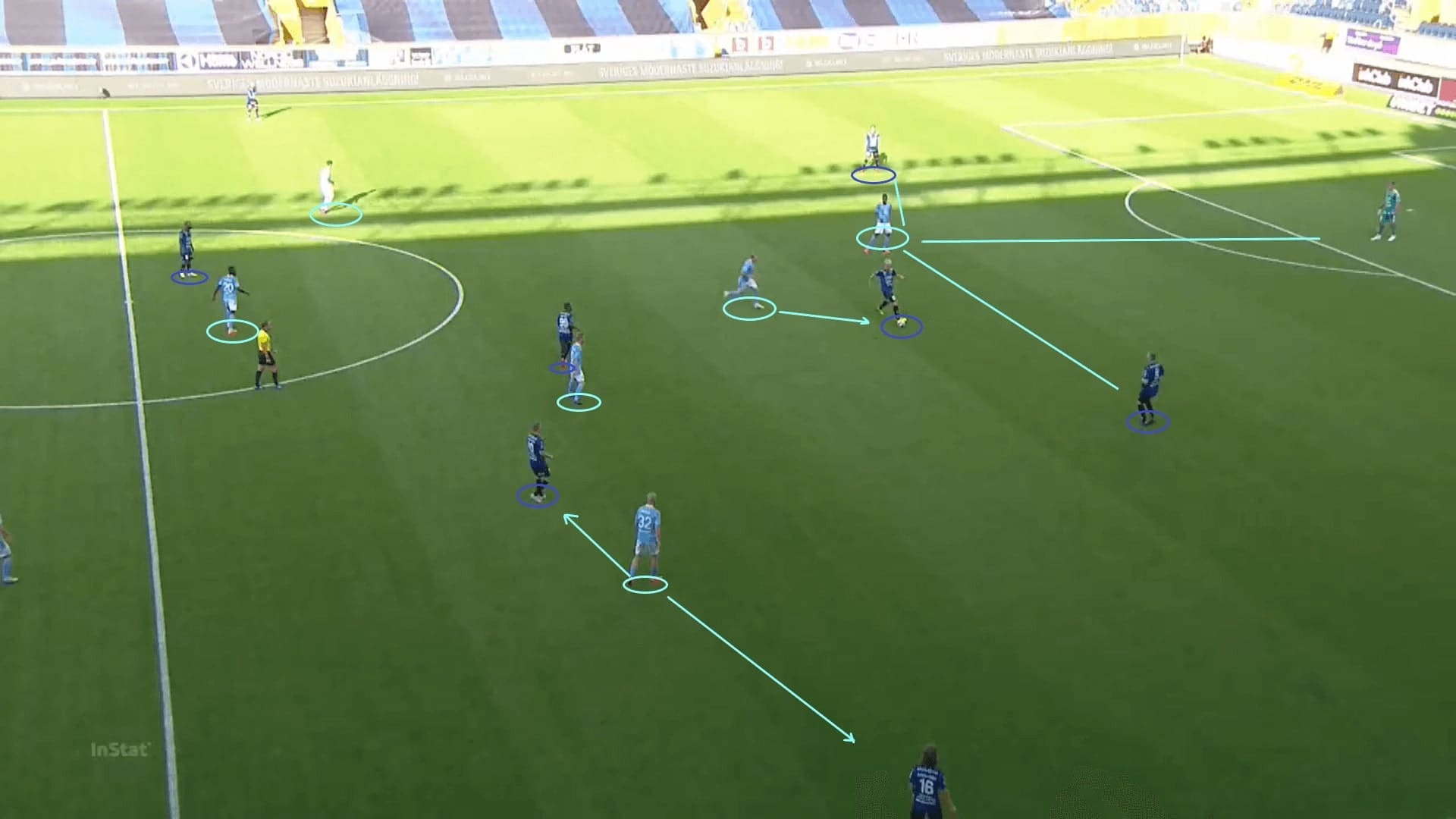
Similar to the previous game, Inge Berget was keen on intercepting the ball by stepping out very early to a wide target. Sometimes the press collapsed because of him, but the Malmö #32’s off-the-ball efforts were quite important. A coin has two sides – the energy of Inge Berget has contributed to the 4th goal of Malmö.
This was an example of the peculiar, or maybe, suboptimal pressing behaviour of Inge Berget. In fact, Sugita was passing to the left-back, not the direction where Inge Berget was going to.
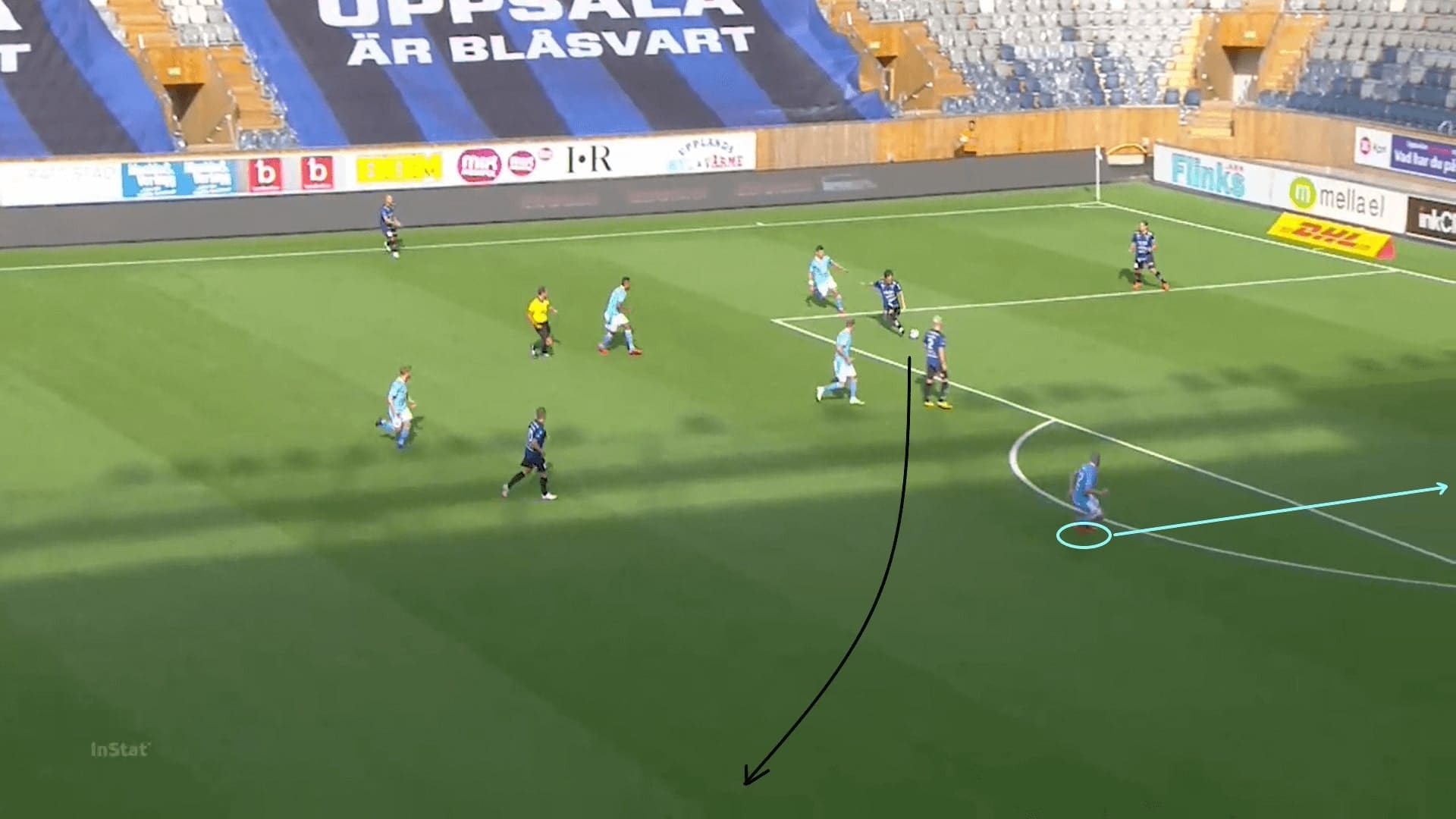
In the second half, one of the substitutions was quite smart – Rieks replaced Antonsson at the left-winger position. The 33-year-old Danish player was another hardworking player when out-of-possession. Apart from his simple touches to connect Safari in the offensive third, Rieks was doing a great job to cover the wide areas.
In this example, Sirius were doing what they did usually – using Sugita to take away the left-back, opening the passing lane and spaces for the right-back. However, the advantage was nullified because Rieks was disciplined to join the last line, covering those areas.
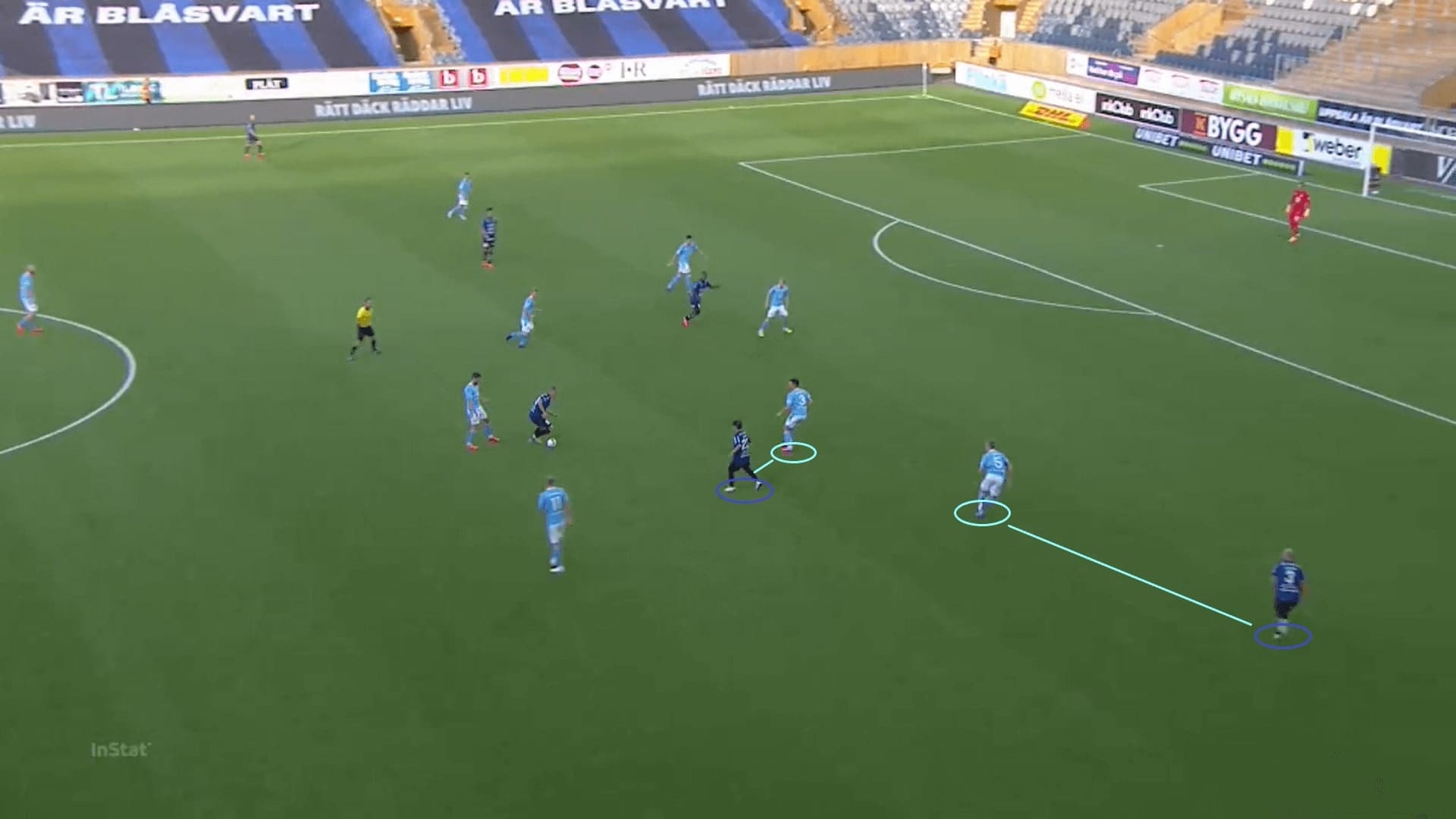
Sirius positional plays
Sirius were playing in a 4-3-3, pushing the full-backs high and wide. Adam Hellborg, as the pivot, would drop between or move around the centre-backs. This could place Axel Björnström and Daniel Jarl at the half-spaces, allowing the free player to carry the ball out of the first line.
This was more commonly seen on the right flank, Björnström was more comfortable to bring the ball forward. As the right-winger, Yukiya Sugita was operating narrowly, in between the lines. The Japanese player was good at turning in tight spaces, would be a good progressive option to create something in the final third.
In this example, Karl Larson stretched the width and fixed Safari’s attention, enabling Sugita to receive the ball between the lines. This generated spaces and the time for Sugita to turn after receiving the pass from Björnström.
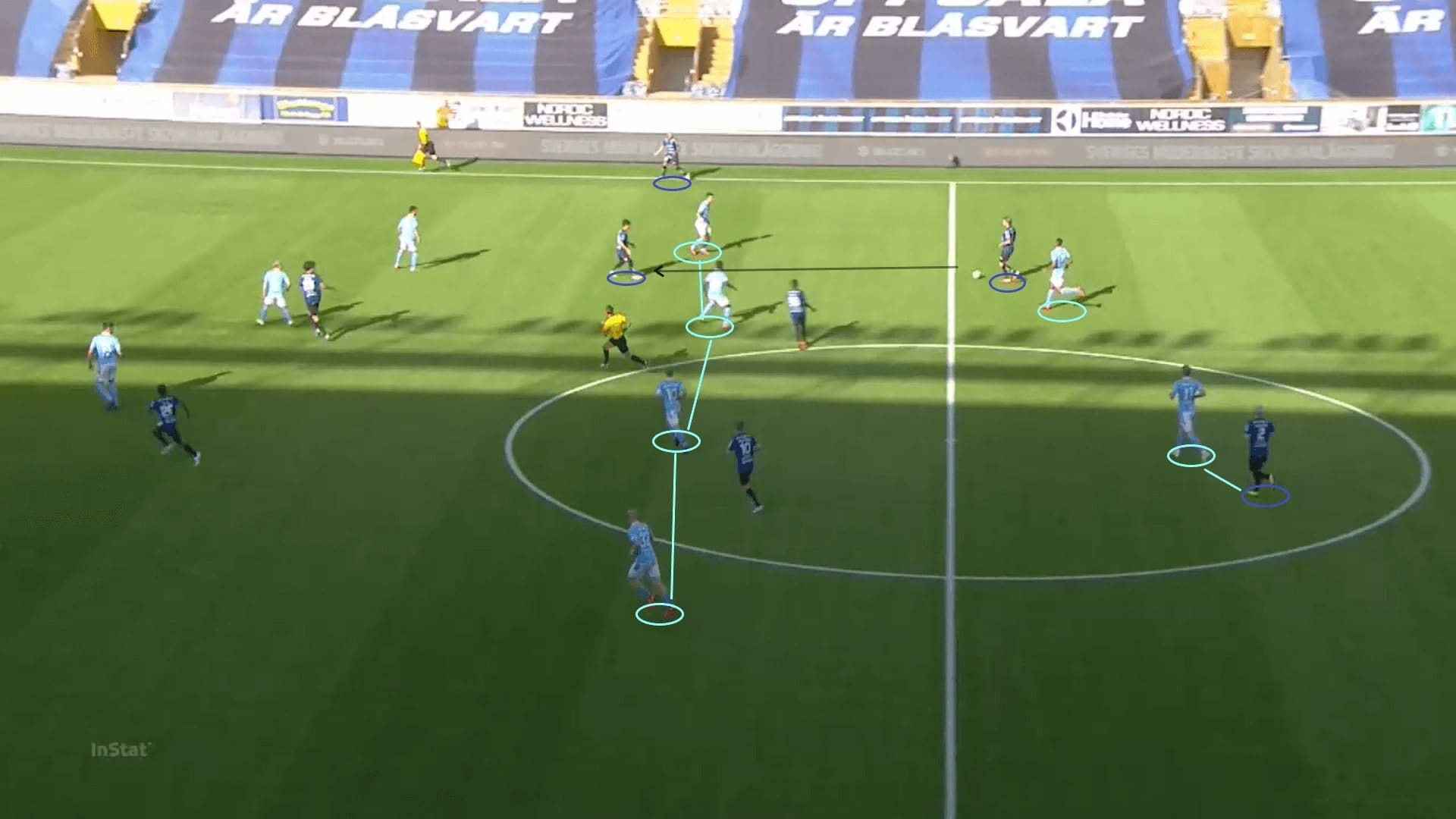
Around midway through the first half, Rydström switched the positions of several players. Roche stayed higher to allow Girmai Netabay and Sugita to play deeper. Saeid played as the striker again. This was a strategy to counter the high press of Malmö. Despite some suboptimal decisions in the build-up phase, the false-wingers helped the team to break the press on some occasions.
The composure, movements and “La Pausa” skillset of Girmai Netabay was better than Roche. When he has involved the build-up, the connection with the wide full-backs was stronger and his passes was a good source of the out-balls.
When the winger was dropping from a high position, mostly the full-backs were busy dealing with the full-backs. Innocent went higher as Malmö needed to regain the ball, so the player dropping would not be tracked. This scenario is an example, Sugita received once again connected with Björnström, as Innocent did not know the Japanese was dropping from the blindside.
However, the quality in the final third could be better. At times Sirius players arrived at the edge of the box, they took a shot despite there might be better decisions. In the second half, Sirius could not control the ball because of the rhythm and speed of the game, they were more likely to generate the opportunities in the transitions or through the individual quality of Holmquist Vecchia.
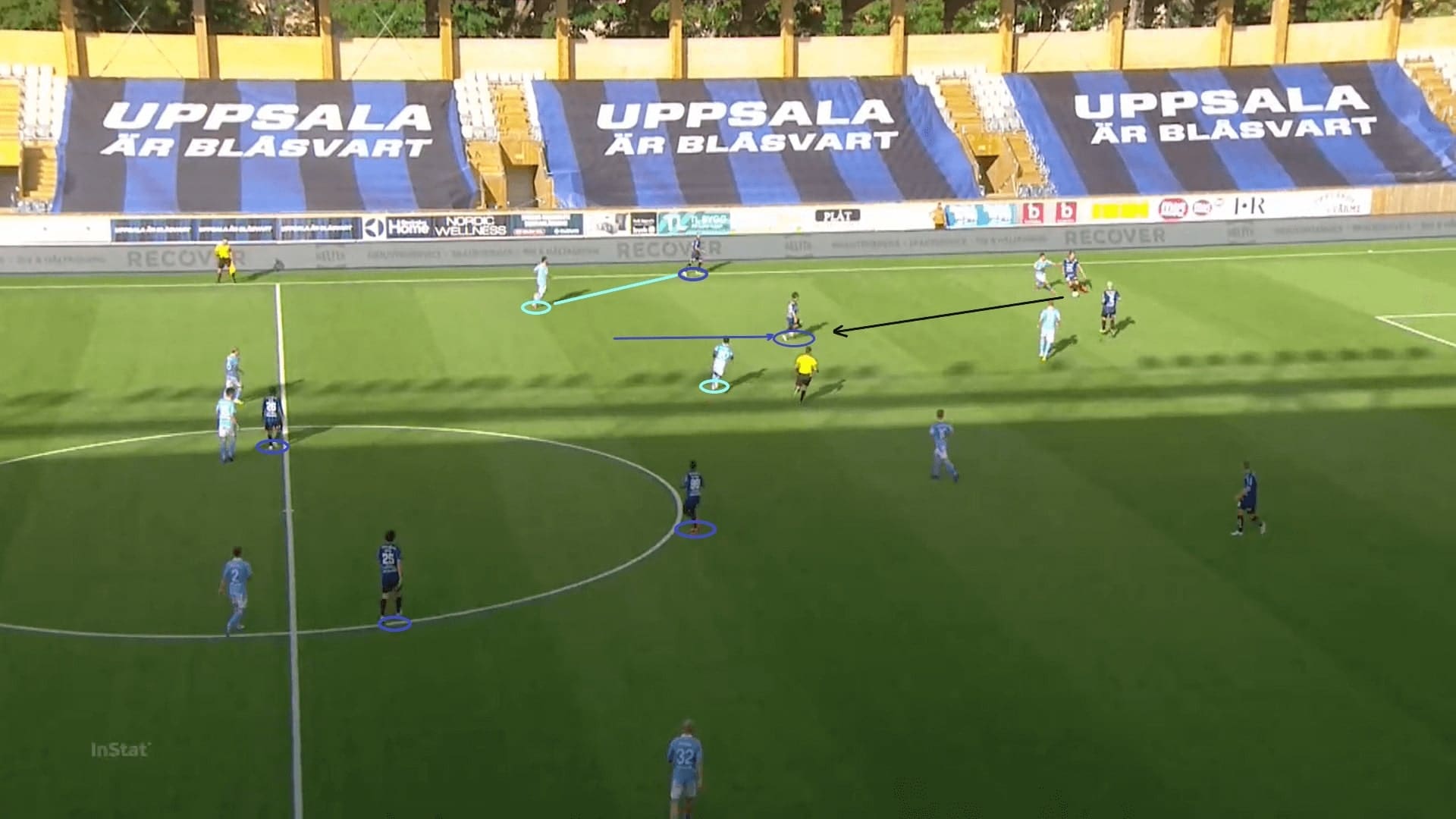
Sirius defensive style of play
Sirius were adopting a similar defensive approach from the previous games, overloading the centre and pressing wisely. They wanted to control the opposition midfielders while shutting the passing lanes to full-backs, so, the wingers had to curve the runs. This would shadow one passing lane while pressing the carrier – Saeid did this to shadow Eric Larsson while pressing Anel Ahmehodžić below.
The narrow wingers would allow the defensive shape staying to maintain compact during the press. The players were shifting the marking duties across situations. In this example, Sugita and Roche were marking the pivot.
Closing the central options would force the ball to Malmö’s full-backs or a long ball. If the ball went wide, the Sirius winger or the full-back could jump to the receiver instantly, limiting the quality of the long pass. Playing with a back four and a deeper pivot has helped Sirius to reduce spaces between the lines, making the recoveries of second balls more effective.
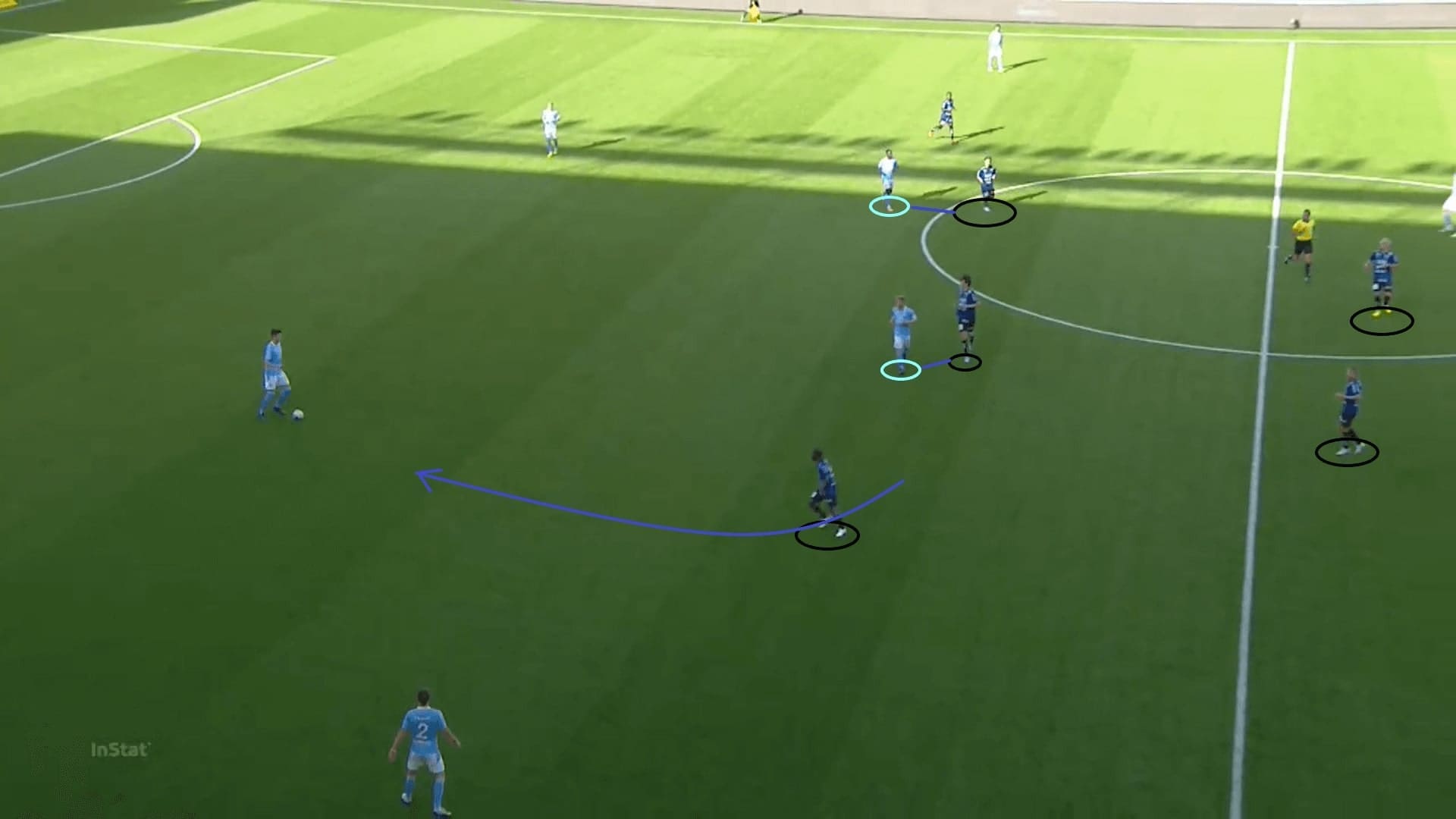
A slight tweak would be the deeper positionings of the midfield, to minimize vertical spaces between the lines, Hellborg stayed deeper than usual. Sometimes he was joined by another midfielder as Malmö often roamed the false-winger narrowly. We have seen Ahmehodžić connecting with Toivonen to break the defence within the block, the close proximity of this block was aimed to prevent these situations from happening.
In this image, we have drawn the shape of the defence. The backline and the midfield line were very compact, horizontally and vertically. Plus, the pressing players were trying their best to shadow the centre, so the passing lane to the players between the lines was not available. This has troubled the opponents’ attack and Malmö only registered one negligible shot in the first 45 open plays.
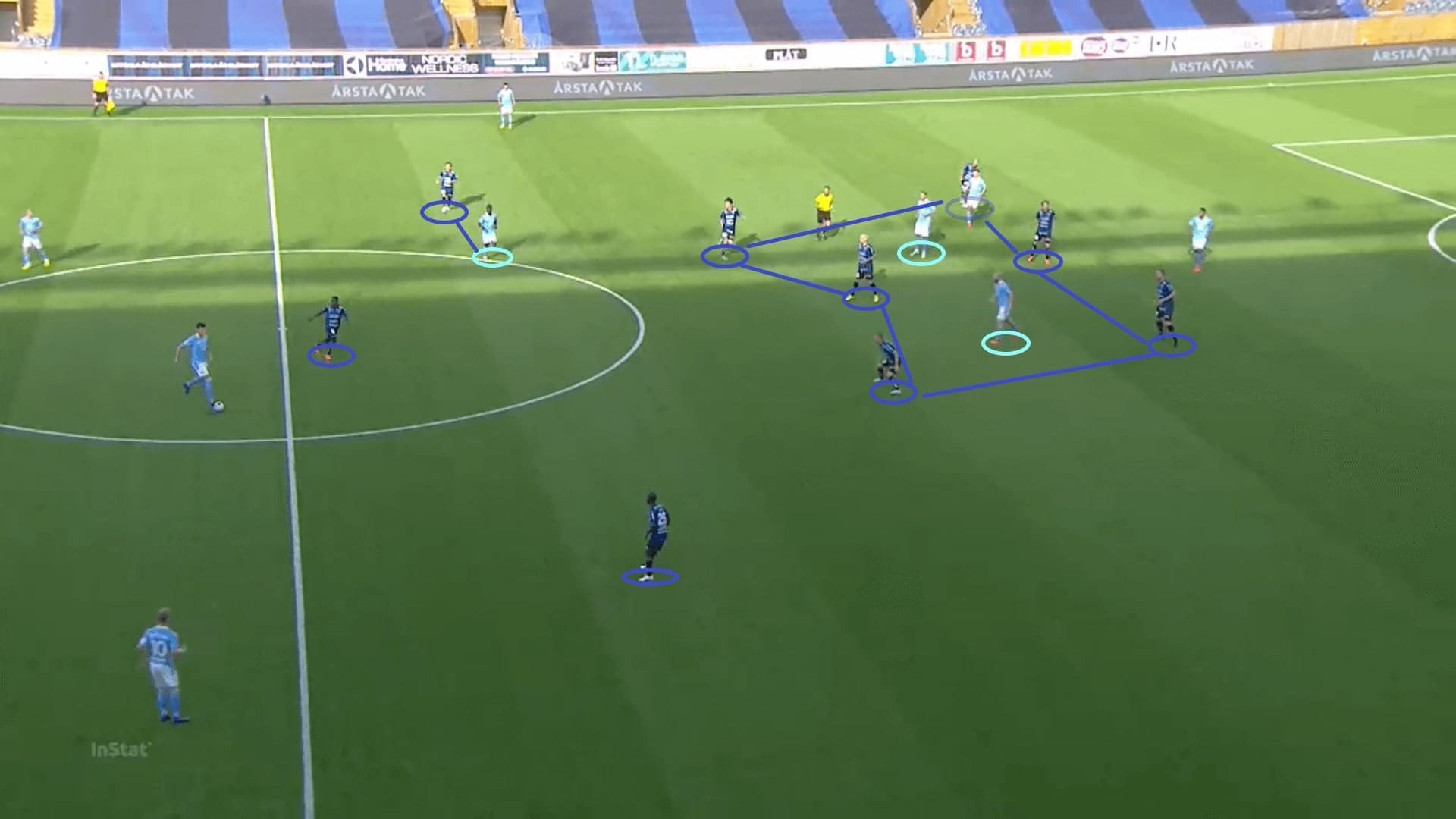
Although the midfield press was planned with clear intentions and strategies, Sirius had a difficult second half because Malmö also boosted the attack. By more frequent exchange positions of the pivots and full-backs, also the dropping of Toivonen, it was too much for the pressing player to handle. The wingers were tasked to curve the passing lane to close the ball while shutting a passing lane, but when the opposition stretched very wide, it was difficult to execute this tactic without pushing players forward.
Therefore, even Sirius enjoyed a numerical superiority at the centre, it was suboptimal. Malmö were constructing the attacks through the full-backs. As a reference, Blåsvart overloaded the midfield with a 4 v 3 or a 5 v 3 below, but the pressure on the centre-backs was not enough. Therefore, the opponents were comfortably executing the passes or circulating the ball.
Sugita wanted to press Oscar Lewicki, but the curved-run was impossible to cover Toivonen and Knudsen at the same time. Plus, the Malmö centre-back was a midfielder, very natural on-the-ball and it was easy to find the former Ipswich man. Reaching the left-back, he could either move in to combine with the pivots, or trying to release the winger.
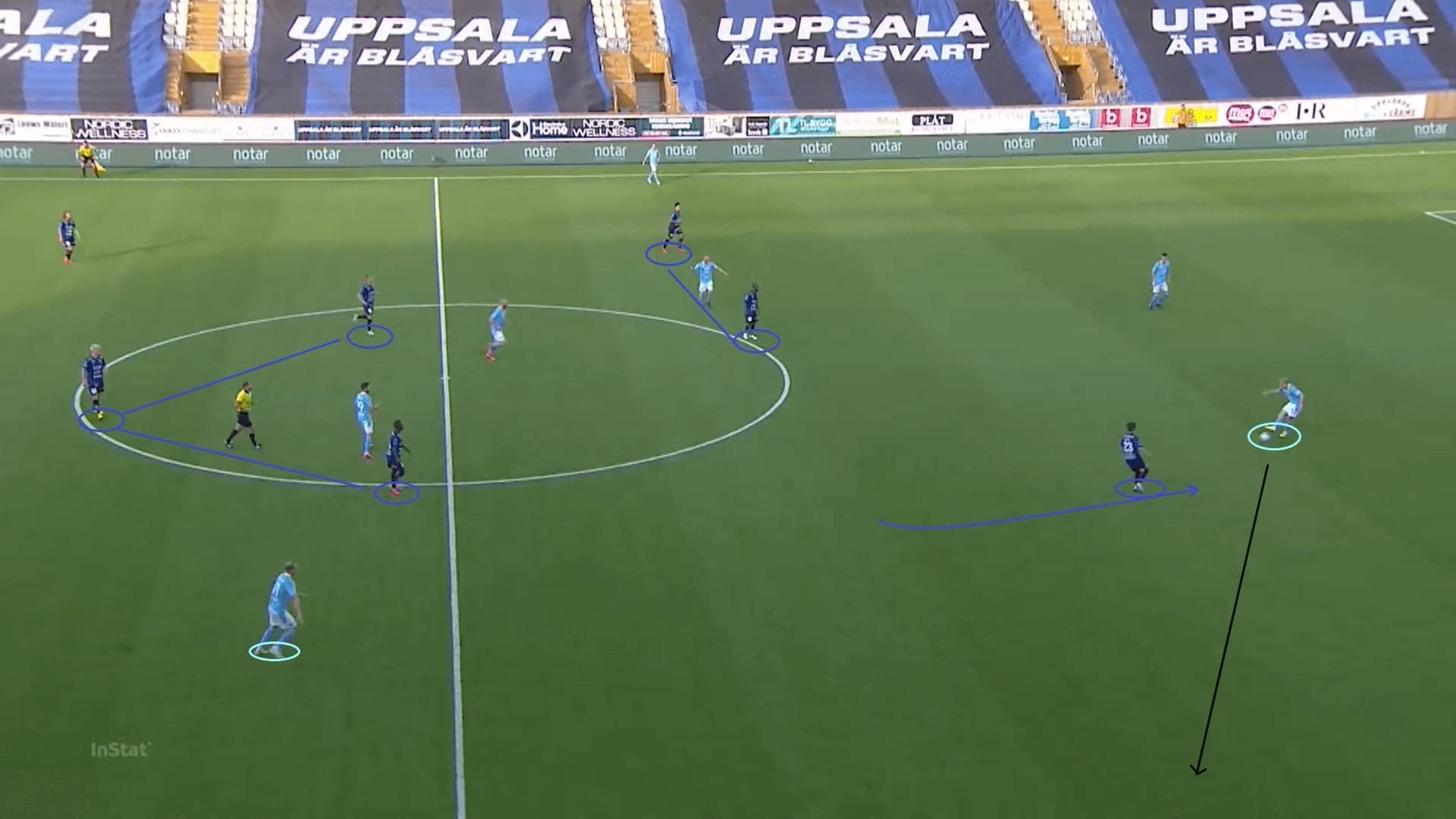
Malmö’s quality in the attacks
In the first half, the performance of Malmö was not good. As explained in the above analysis, Sirius came with a press that tried to make the first phase difficult. Under strategic and continuous pressure, it was difficult to create chances.
Ahmehodžić was the better ball-playing centre-back, but his connection with Toivonen in the first half was weaker. It was because of the shadowing efforts of Blåsvart and the deep positionings of Hellborg. Consequently, the main way to progress was throwing long balls upfield, but the guest did not do this with a very clear principle, hence, it was suboptimal.
In some cases, Toivonen might connect with a lofted pass but the continuity was low, Malmö were still not too comfortable to play in tight spaces. The wingers were operating narrowly to attack the backline, but the close proximity did not lead to any combination plays or third man efforts, even a 3 v 2 advantage was created as follow.
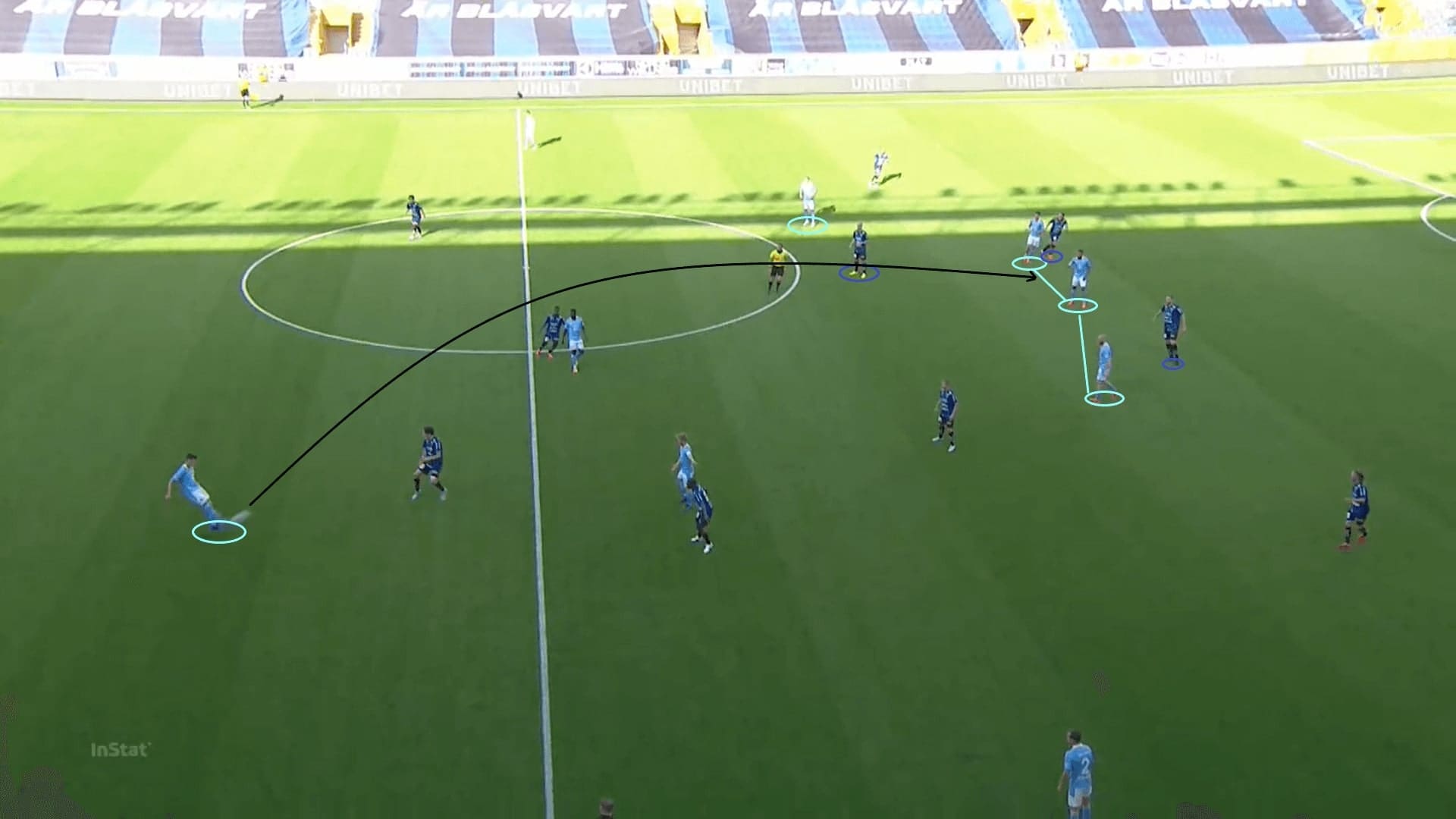
The issue was a bit similar with the previous games, as the free players on the pitch were the full-backs, if Sirius allowed them to be. Sometimes Blåsvart were not able to shut the cross-field passes, so connecting Larsson and Safari was possible.
However, the relatively deep positionings of the full-backs have led to the inefficacy of long balls. The forward passes were distanced from the receiver – mainly the wingers who made the outward movements. Sirius full-backs had the time to read and get to the ball first on most occasions. Or, sometimes the Malmö full-backs have invited the pressure but failed to evade, and Larsson and Ahmehodžić tried losing the ball in the own third.
In this example, even Larsson was the free player, it was difficult to connect Inge Berget because of the tight marking. The right-back played a difficult curved and chipped ball to the centre but again, Malmö were forced to play in tight spaces and having difficulties to further progress.
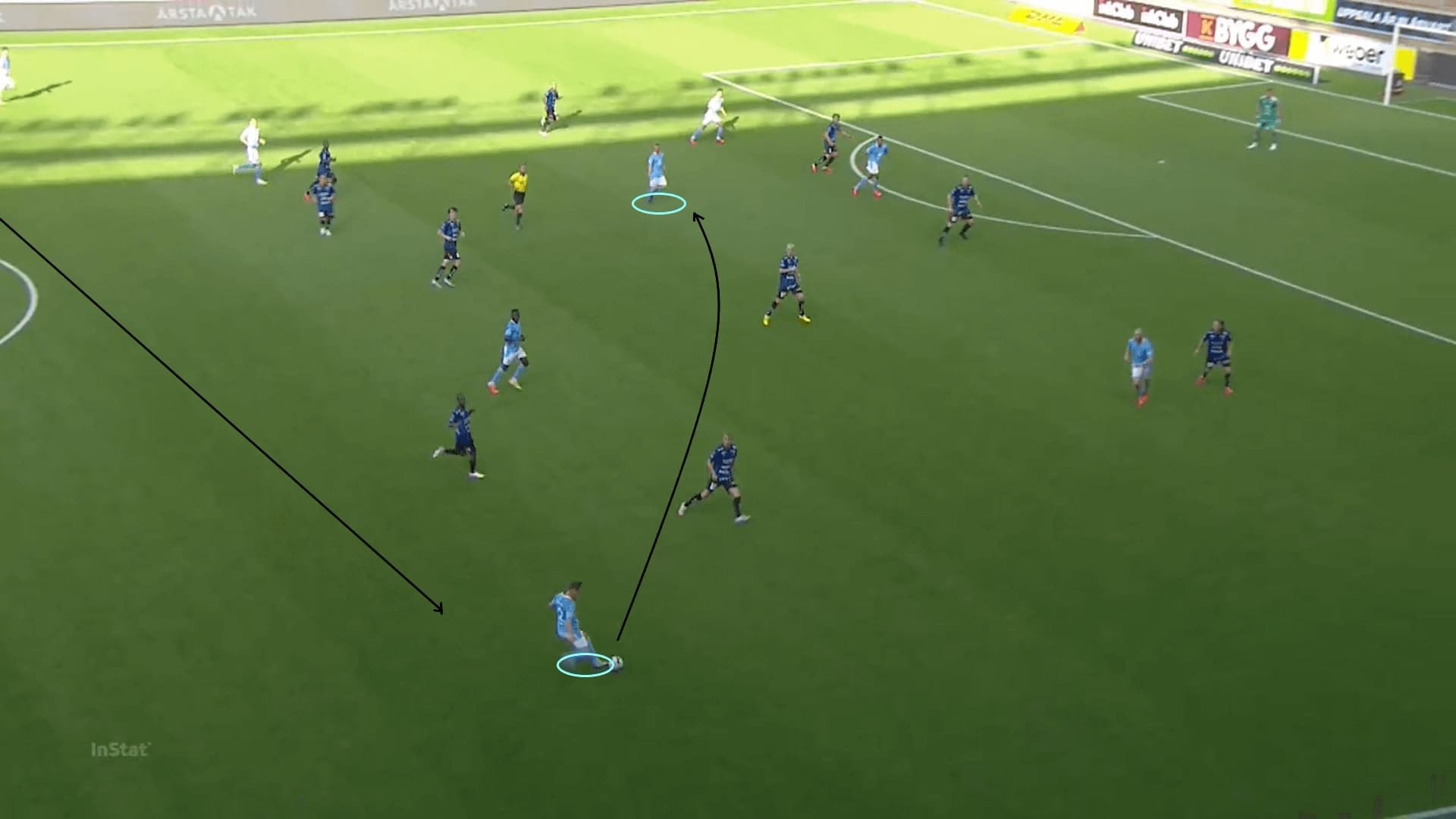
In the second half, Tomasson had to change something, the key was to get the best player on the ball – Toivonen. I have to mention again, the playing experiences in Ligue 1 and the Premier League have made the Malmö #11 a better player. His performance is too classy.
Toivonen dropped more often in the central third, as a connection point to increase the interconnectedness of players, also opening the passing lanes for the ball. Assuming Sirius were pressing, then, numerical equality was available at flanks. The presence of Toivonen became the additional “+1” option for the team, which was difficult to track.
As a reference, Malmö were attacking with Knudsen on the ball. And, finding Toivonen, the free player would be an optimal solution to evade the pressure.
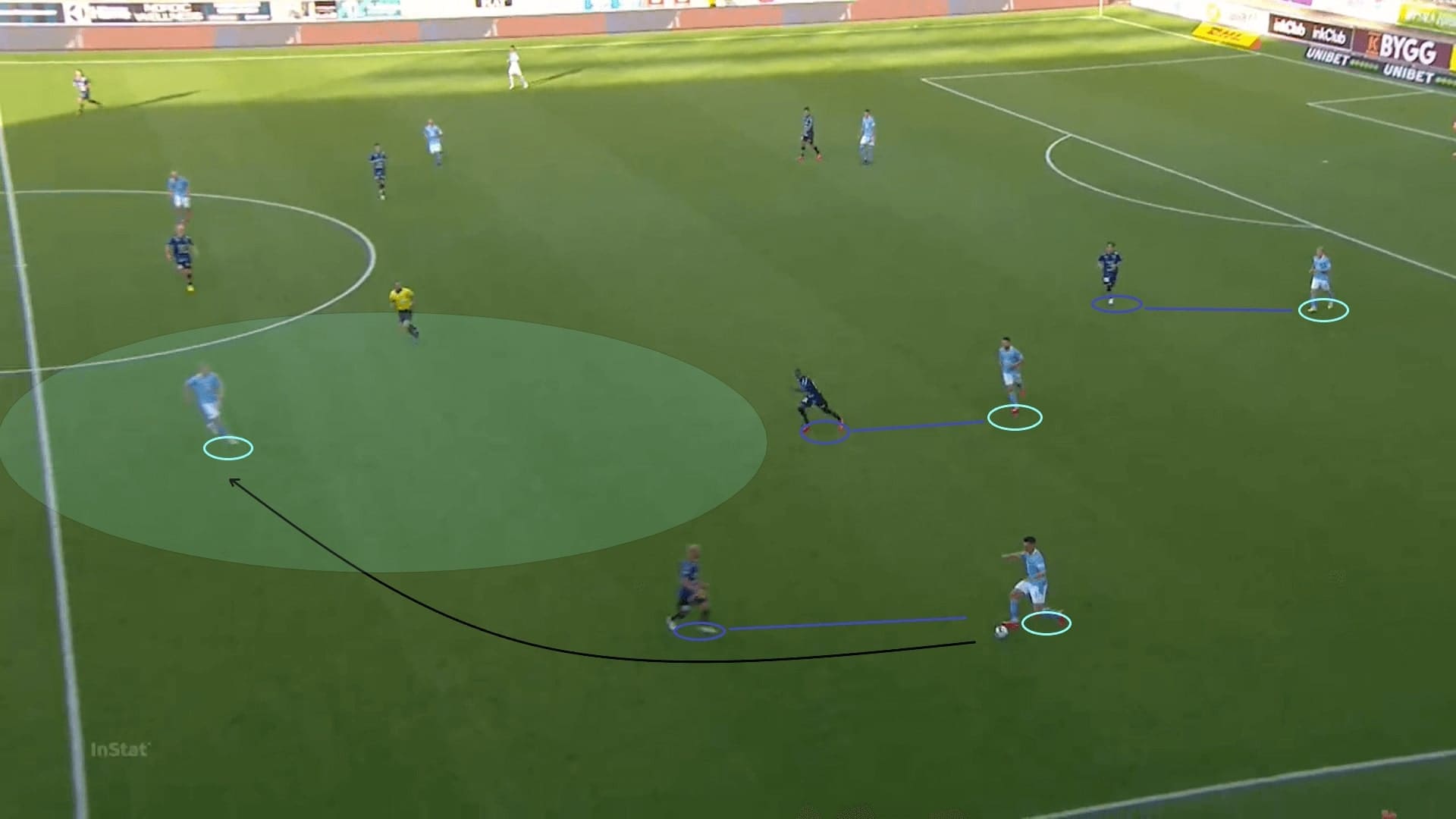
Intriguingly, the xG of Malmö were even lower than Sirius, but they scored five goals. The quality in the final third and moments of brilliance have made the difference. The finishing of Tomasson’s team was better, and again, we stress the brilliance of Toivonen in Kiese Thelin’s goal.
This was a fast break, Toivonen was the highest point of the attack and his movements were brilliant. When Inge Berget was carrying the ball, Toivonen was not dashing to the penalty box with full speed because this might draw the centre-back’s attention. Instead, when moving forward, Toivonen kept himself on Kebba Cesssay’s blindside, also seized the moments to scan the pitch to a right direction. With this, he perceived the information he needed – understood the situation at the back post. This has led to his great move before assisting Kiese Thelin.
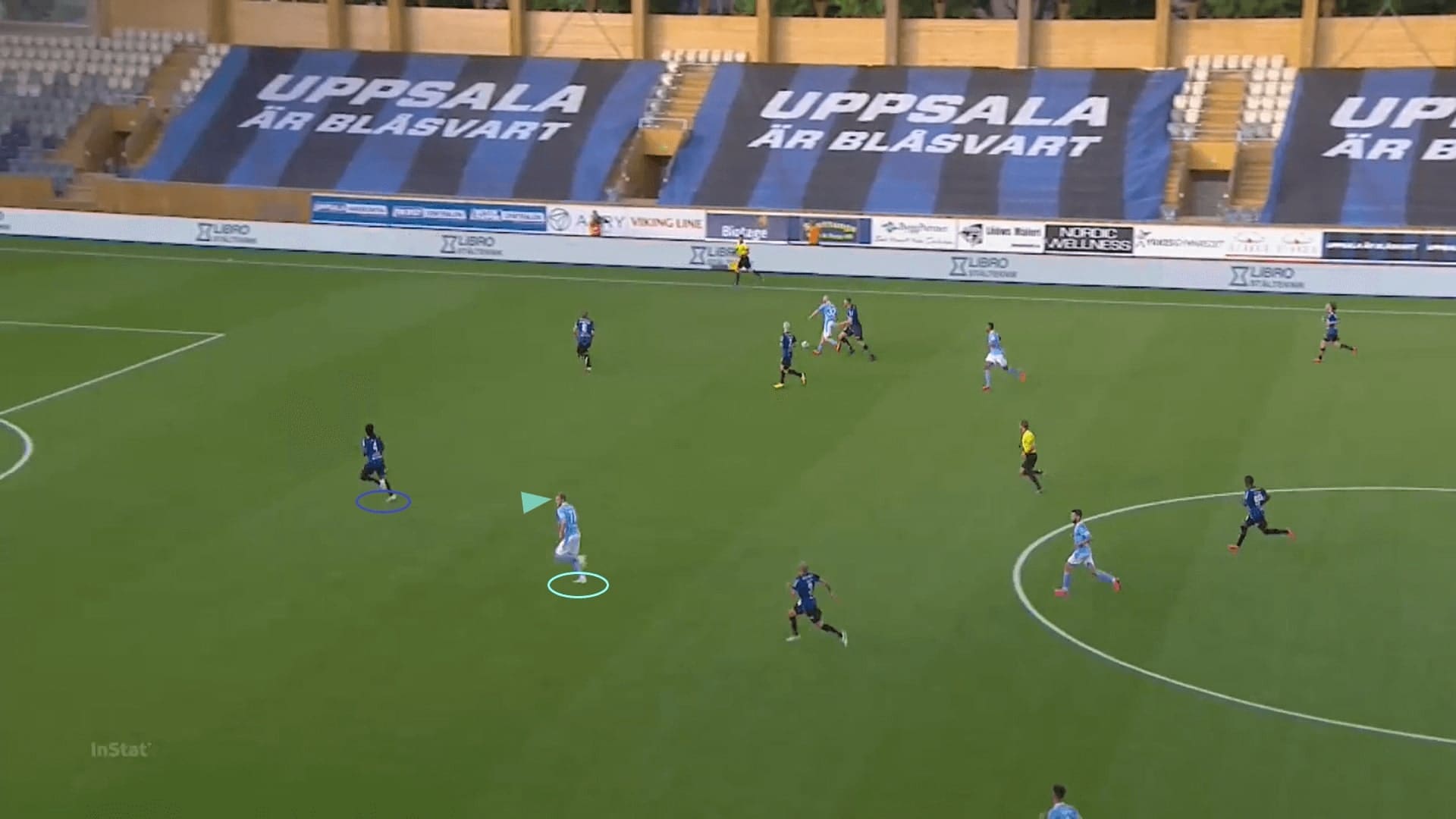
Moments to trigger the counter-attacks
In the last section, we are addressing some moments in the transitions. Both teams got their chances in this phase because of some key individuals. For Malmö, it was Toivonen, who had qualitative superiority and tactical intelligence to create something.
Even Toivonen was not the target man, the timing of his passes and movements were great. We showed you the Kiese Thelin goal and his involvement. In this example, the situation was a bit different, but what impressed us was the absorbing pressure behaviour of Toivonen – he paused a bit to attract three Sirius players, then, softly released the ball to the supporting player and Malmö could carry on the counter-attack.
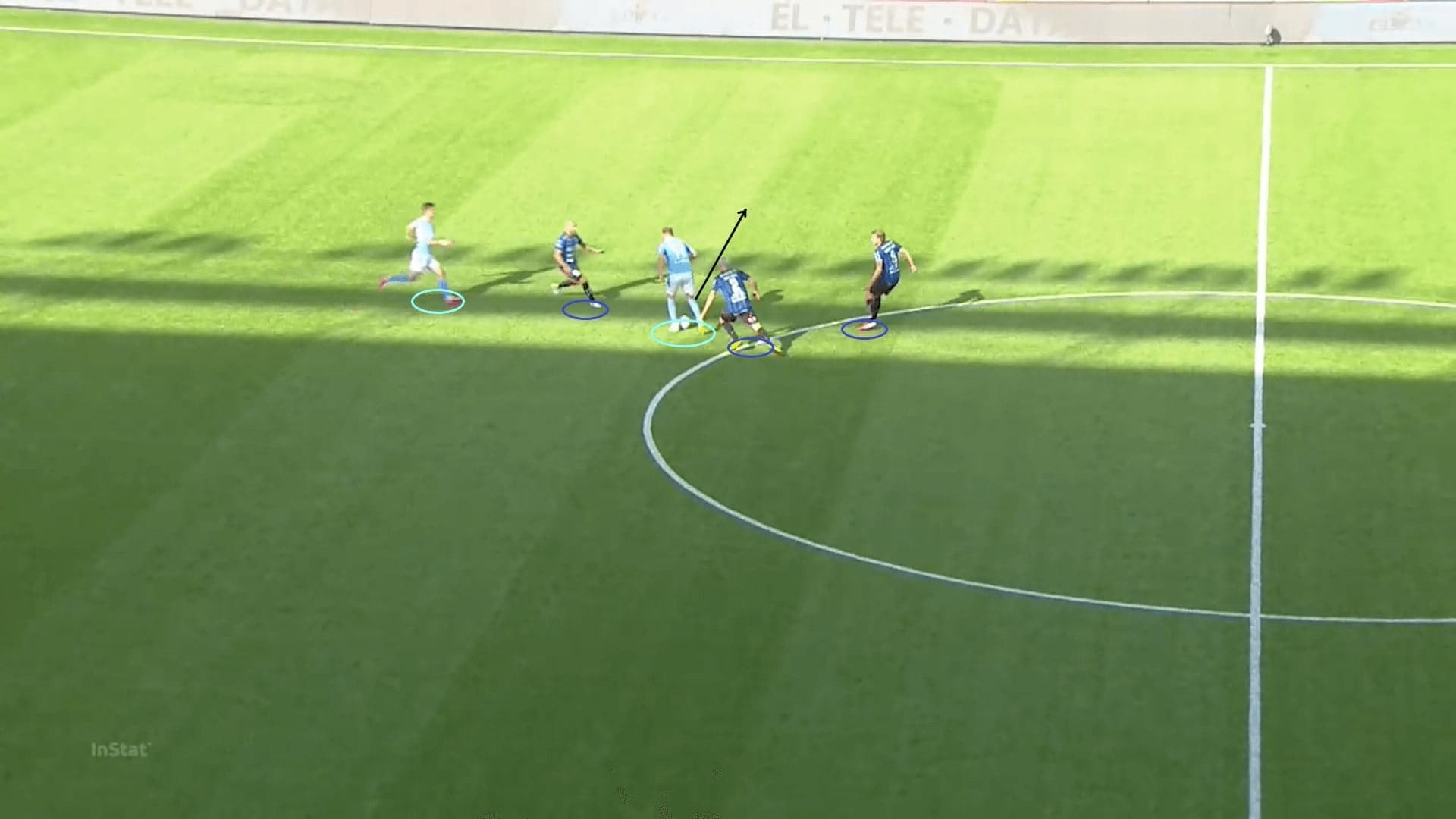
From Sirius’ perspective, Holmquist Vecchia or Sugita were the players to develop the counter-attacks. Their pace and dribbling abilities were great tools to challenge the opposition defence. However, credits should also be given to Hellborg, who was the main player to trigger these dynamics.
Offensively, especially on-the-ball, Hellborg was thinking quite fast and at times he picked a progressive option once regained possession. This was an example, using his chest to control the dropping ball, and the second contact was already a forward pass to connect Girmai Netabay between the lines.
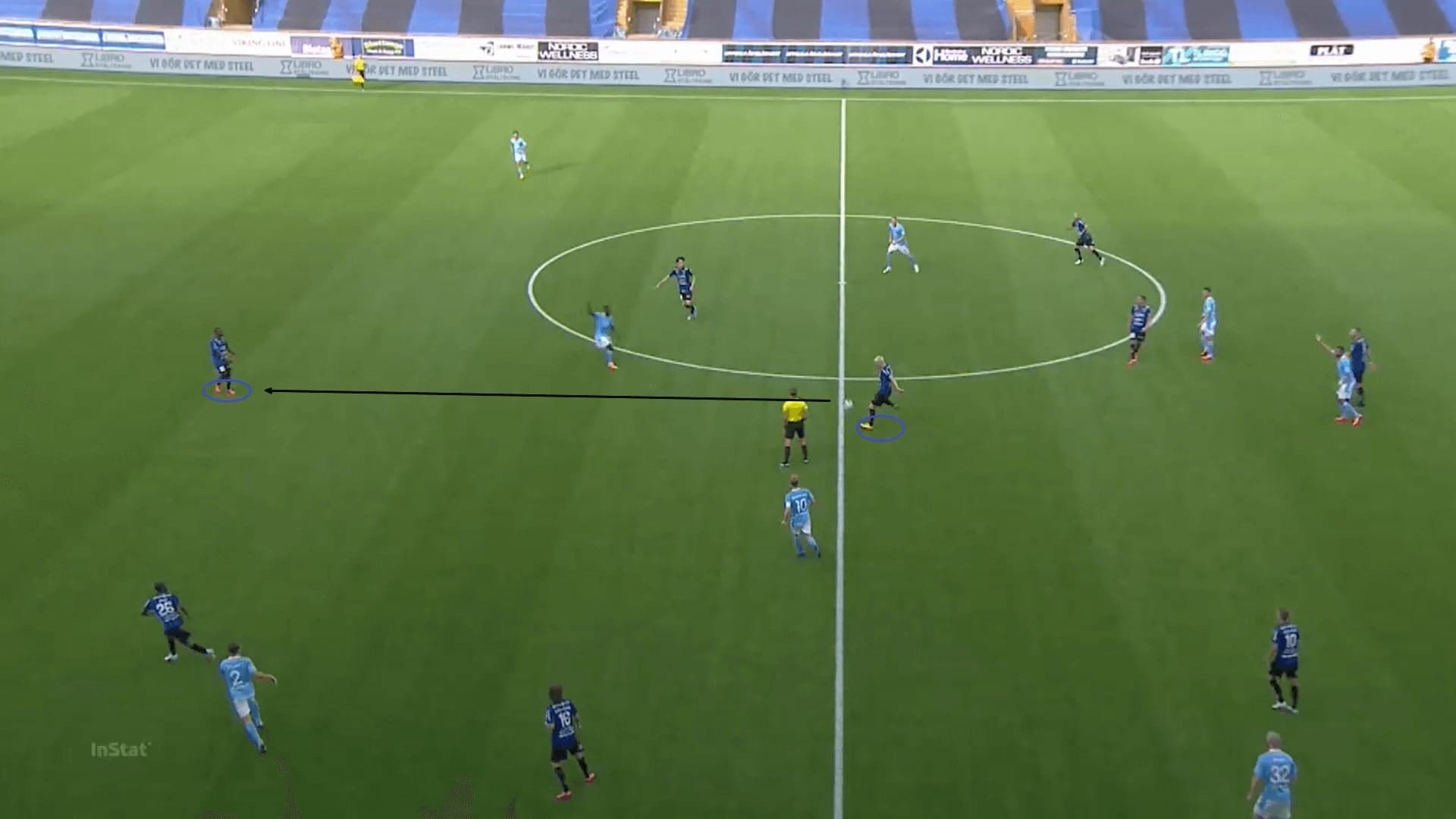
Final remarks
Sirius were slightly better than Malmö in the first half, the away side only had 0.3 xG and two shots, and the majority of this figure was generated in the dead-ball situation. Rydström’s team had moments to extend the lead, but the crosses and the threat towards the goal were not dangerous enough.
Malmö were not convincing as the scoreline has suggested, but the fighting spirit of the team was amazing. Every time Tomasson urged his team to boost the performance at the halftime, they came up with some rewards. Since Norrköping recorded another draw on Sunday, Malmö reduced the margin with the top of the table to two points.





Comments